Digital Futures, Archaeological Pasts: Student-Curated Exhibition Opens October 25 in Fine Arts Gallery
 During the spring semester 2018, nine history of art students studied a selection of ancient Mediterranean antiquities in the collection of the Vanderbilt University Fine Arts Gallery. The objects at the center of the exhibit range in date from the sixth century BCE to the first century CE and include Greek and Etruscan vases, a Greek coin, and a Greco-Roman marble sculptural head. In addition to exploring each object’s historical context and significance, the students learned photogrammetry, a process for generating digital models of 3D objects through photography. By creating and printing these digital 3D models, students sought insight into how new, digital approaches might facilitate research into, and engagement with, ancient material and visual culture.
During the spring semester 2018, nine history of art students studied a selection of ancient Mediterranean antiquities in the collection of the Vanderbilt University Fine Arts Gallery. The objects at the center of the exhibit range in date from the sixth century BCE to the first century CE and include Greek and Etruscan vases, a Greek coin, and a Greco-Roman marble sculptural head. In addition to exploring each object’s historical context and significance, the students learned photogrammetry, a process for generating digital models of 3D objects through photography. By creating and printing these digital 3D models, students sought insight into how new, digital approaches might facilitate research into, and engagement with, ancient material and visual culture.
Digital Futures, Archaeological Pasts, on view in the Vanderbilt Fine Arts Gallery from October 25 through December 6, is the fifth student-curated exhibition to result from a partnership between the Department of History of Art and the Fine Arts Gallery, this time led by Veronica Ikeshoji-Orlati, CLIR Postdoctoral Fellow for Data Curation. The exhibition, curated by Aleah Davis ’21, Joseph Eilbert ’19, Brant Feick ’18, Lindsay Fraser ’19, Kinsley Ray ’21, Gabrielle Rodriguez ’21, Heaven Russell ’21, Kalen Scott ’21, and Sarah Taylor ’18, is supported, in part, by the Department of History of Art.
An opening reception will be held on Thursday, October 25, from 5 to 7 pm in Cohen Memorial Hall.
The Fine Arts Gallery is located in Cohen Memorial Hall at 1220 21st Avenue South on the Peabody College campus. Gallery hours are from 11 am to 4 pm Monday through Friday, and from 1 to 5 pm weekends. Parking is available in all non-reserved spaces in Lot 95 near Cohen Hall on the Peabody campus.
*Photo illustration of the 3D scanning of a red-figure skyphos, Etruria (Italy), ca. 340-300 BCE. Polychromed terracotta, Peabody College Collection, 1979.643P.
Posted by vrcvanderbilt on October 21, 2018 in Digital Humanities, Events, Fine Arts Gallery, HART, News, Student/Alumni, Technology, Vanderbilt University, VRC
Photographic Exhibit Captures Pompeii’s Ongoing History As An Archaeological Site
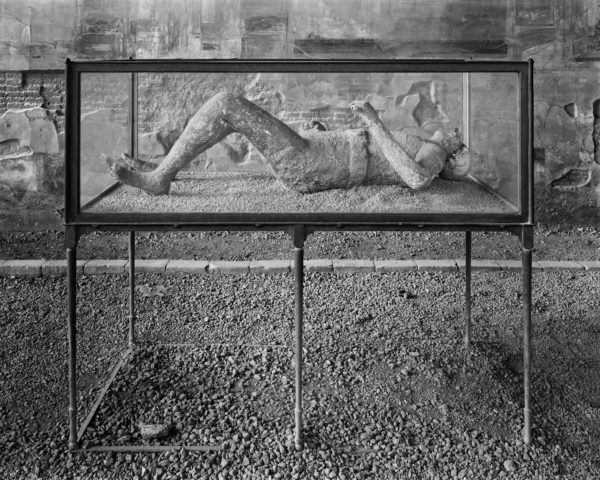 Destroyed by the eruption of Mount Vesuvius in 79 CE, the ancient city of Pompeii has captured the imagination of the public since it was first excavated in 1748. Pompeii Archive: Recent Photographs by William Wylie, on view in the Vanderbilt Fine Arts Gallery from October 25 through December 6,.features a selection of recent work by artist and photographer William Wylie (American, born 1957) that explores the famous archaeological site. Alongside Wylie’s contemporary photographs are several by Giorgio Sommer (1834-1914), a German photographer who documented the excavation of the site in the mid-nineteenth century. An opening reception will be held on Thursday, October 25, from 5 to 7 pm in Cohen Memorial Hall.
Destroyed by the eruption of Mount Vesuvius in 79 CE, the ancient city of Pompeii has captured the imagination of the public since it was first excavated in 1748. Pompeii Archive: Recent Photographs by William Wylie, on view in the Vanderbilt Fine Arts Gallery from October 25 through December 6,.features a selection of recent work by artist and photographer William Wylie (American, born 1957) that explores the famous archaeological site. Alongside Wylie’s contemporary photographs are several by Giorgio Sommer (1834-1914), a German photographer who documented the excavation of the site in the mid-nineteenth century. An opening reception will be held on Thursday, October 25, from 5 to 7 pm in Cohen Memorial Hall.
Wylie’s interest in the contemporary state of Pompeii began with his discovery of Sommer’s work. An avid historian, Wylie, professor of art, University of Virginia, was especially intrigued with Sommer’s strategic use of photography to flatten the picture plane and create layered and stratified images evocative of the archaeological process. “For me, much of the mystery of Pompeii lies in the site’s layers,” said Wylie. “Archaeologists work by uncovering and studying the deposits of past eras, but even visitors experience the site in this way. I was motivated to try and make photographs that revealed some of Pompeii’s complexity, the way multiple pasts intersect there with our 21st-century present.”
The exhibition features eighteen large-scale photographs focused on the ongoing process of restoration, discovery and collection of archival remains and materials from the eruption of Mount Vesuvius in 79 CE. Through Wylie’s photographs, Pompeii is seen as a constantly changing—not static—archaeological site. Photographing on analog black and white film with an 8 x 10 large-format camera, the artist creates highly detailed images that evoke Sommer’s nineteenth-century oeuvre and the transitions that continue to mark the site and landscape in the 21st century. Ever curious as to how landscapes accumulate visual markers and meanings, Wylie notes in his artist statement that “change is inescapable at Pompeii. . . .I document the changing relationships between artifacts, ruins, spaces, and the passage of time.”
His working method incorporates repeated visits to a site; an immersion in which he gains an understanding of both the cultural and natural landscapes that create place. For the ongoing Pompeii project, Wylie traveled extensively to the archeological site, gradually building friendships and the trust of site supervisors and archivists, and gaining access to areas of the site and storage facilities not available to the general public.
This ongoing research, and the body of work that has resulted, was supported by Yale University’s Doran Artist in Residency awards at the Sol and Carol LeWitt estate in Praiano, Italy, where Wylie was a resident in 2012 and 2015.
Pompeii Archive: Recent Photographs by William Wylie, organized by the Gregory Allicar Museum of Art at Colorado State University, is brought to the Vanderbilt University Fine Arts Gallery, in part, through the generous support of the Program in Classical and Mediterranean Studies, with additional support provided by the Department of History of Art and the Department of Art.
The Fine Arts Gallery is located in Cohen Memorial Hall at 1220 21st Avenue South on the Peabody College campus. Gallery hours are from 11 am to 4 pm Monday through Friday, and from 1 to 5 pm weekends. Parking is available in all non-reserved spaces in Lot 95 near Cohen Hall on the Peabody campus.
§
In conjunction with the Fine Arts Gallery exhibit, Wylie will deliver a lecture, “The Possibility of Ruins: A Pompeii Archive,” on Wednesday, November 14, at 4:10 pm in 203 Cohen Memorial Hall. Free and open to the public, his lecture is made possible by the Program in Classical and Mediterranean Studies.
*William Wylie. Body cast, Macellum (VII.9.7), Pompeii,” 2015, archival pigment print, 37 x 45 inches
Posted by vrcvanderbilt on October 21, 2018 in Events, Fine Arts Gallery, HART, Lectures, News, Vanderbilt University, VRC
Jochen Wierich Chairs Panel at Southeastern Museum Conference October 8-9
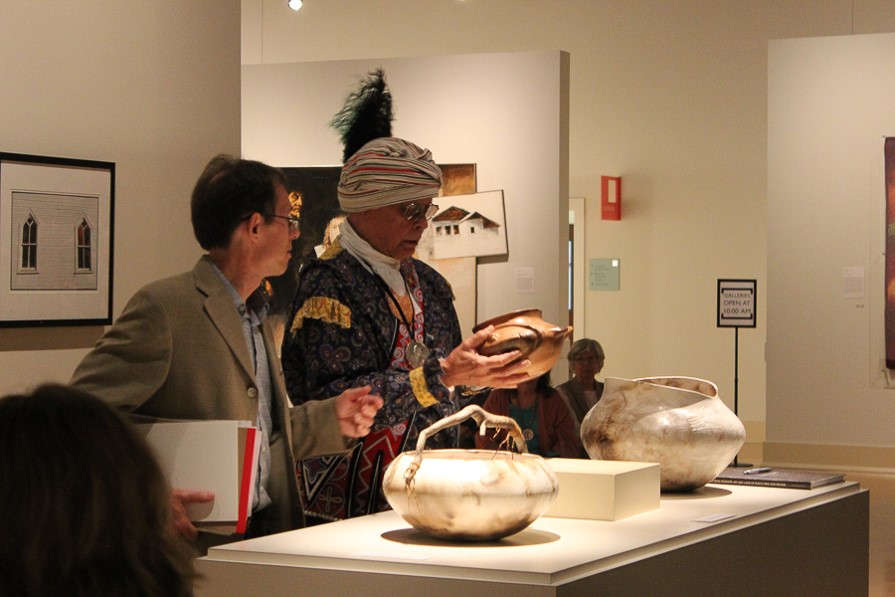 Jochen Wierich, senior lecturer, department of history of art, organized and chaired a session at the Southeastern Museum Conference (SEMC) held October 8-9 in Jackson, Mississippi. The panel, entitled “From Effigy Pipe to Punching Bag: Negotiating the Native American Object in Art Museums,” focused on the challenges and opportunities of representing Native American identity in art museums.
Jochen Wierich, senior lecturer, department of history of art, organized and chaired a session at the Southeastern Museum Conference (SEMC) held October 8-9 in Jackson, Mississippi. The panel, entitled “From Effigy Pipe to Punching Bag: Negotiating the Native American Object in Art Museums,” focused on the challenges and opportunities of representing Native American identity in art museums.
The participants reflected on a broad range of issues in museum display and interpretation of Native American material from Mississippian archaeology to contemporary art. What are the ethical considerations? What are possible strategies and methodologies for non-Native museum professionals? How do we include contemporary native voices in the global art world?
Issues of Native American art in the context of ethnography, art history, and museum strategies of display and narration have preoccupied Wierich, consultant and interim chief curator (2015-2018), for the last three years that he was working on the exhibition Picturing Mississippi, 1817-2017: Land of Plenty, Pain, and Promise for the Mississippi Museum of Art. “When mounting the exhibition, the goal was to present an art exhibition for the bicentennial that included many artistic voices across time and echo the show’s subtitle Land of Plenty, Pain, and Promise,” he said. “We included Native American objects that ranged from the Mississippian period before European contact to contemporary art.” Wierich also compiled and edited an anthology of essays that accompanied the exhibition in conjunction with the bicentennial of Mississippi statehood.
*Photograph of Jochen Wierich with Chickasaw historian Robert Perry at the Picturing Mississippi exhibition at the Mississippi Museum of Art, Jackson, MS
Posted by vrcvanderbilt on October 16, 2018 in Conferences, HART, News, Vanderbilt University, VRC
Explore Ancient Rome with Goldberg Lecturer Bernard Frischer in a Hands-on Workshop on October 11
Bernard Frischer, director of the Rome Reborn project and professor of informatics at Indiana University, will present “Rome Reborn VR: A Demonstration of Recently Published Applications,” a hands-on workshop (with lunch) held Thursday, October 11, from 12:30 to 2 pm in the History of Art’s Visual Resources Center, 134 Cohen Memorial Hall. Participants will be able to use the Oculus Go headset to try out the 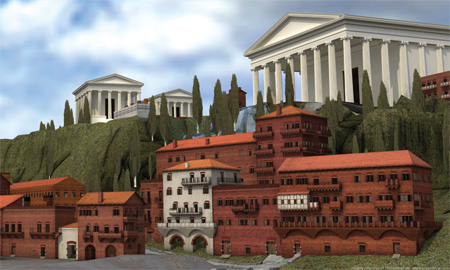 project’s recently published applications, including “The Roman Forum” and “A Flight over the Ancient City.” Everyone is invited to have lunch and explore ancient Rome with us!
project’s recently published applications, including “The Roman Forum” and “A Flight over the Ancient City.” Everyone is invited to have lunch and explore ancient Rome with us!
Following the workshop, Frischer, a leading virtual archaeologist, will deliver the Norman L. and Roselea J. Goldberg Lecture at 4:10 pm in 203 Cohen Memorial Hall on the Peabody campus. Frischer, founding director of the Virtual World Heritage Laboratory, will bring ancient Rome back to life in his lecture, “Adventures in Digital Heritage,” with a reception to follow in the atrium.
“Bernie’s lecture—on intersections between digital humanities and cultural heritage—covers ground on which we are all working closely these days,” said Betsey Robinson, acting chair and associate professor of history of art. “The lecture will also serve as our HART Alumni/Reunion event, with a reception to follow, so hopefully this will provide us a chance to catch up with each other as well as former students.”
On October 10 Frischer and sculptor Alan LeQuire, known for his monumental sculpture of Athena Parthenos in the Nashville Parthenon, joined Professor Betsey Robinson’s Digital Heritage: Methods and Practice class for a roundtable with students at the Center for Digital Humanities. They discussed their methods for reconstructing the Athena Parthenos both virtually and physically.
Posted by vrcvanderbilt on October 8, 2018 in Digital Humanities, Events, HART, Lectures, News, Student/Alumni, Technology, Vanderbilt University, VRC
Hermann Haller to Deliver Lecture on Monday, October 8
Hermann Haller, professor of Italian, comparative literature, and French, Queens College, CUNY, will present a lecture entitled “Between Local and Global: The Italian Language in Urban America” on Monday, October 8, at 2:20 pm in Furman Hall 311.
 Haller’s primary research interests are Italian linguistics and dialectology, Romance philology, Italian as an immigrant language, and dialect literature. A member of the Accademia della Crusca, he prepared the first critical edition of John Florio’s A Worlde of Wordes (University of Toronto Press, 2013), which features 46,000 Italian entries—among them dialect forms, erotic terminology, colloquial phrases, and proverbs of the Italian language. A Worlde of Wordes was the first-ever comprehensive Italian-English dictionary published in 1598 by Florio.
Haller’s primary research interests are Italian linguistics and dialectology, Romance philology, Italian as an immigrant language, and dialect literature. A member of the Accademia della Crusca, he prepared the first critical edition of John Florio’s A Worlde of Wordes (University of Toronto Press, 2013), which features 46,000 Italian entries—among them dialect forms, erotic terminology, colloquial phrases, and proverbs of the Italian language. A Worlde of Wordes was the first-ever comprehensive Italian-English dictionary published in 1598 by Florio.
Sponsors of Haller’s lecture are the Department of History of Art, Department of French and Italian, Max Kade Center for European and German Studies, and the Robert Penn Warren Center for the Humanities.
Posted by vrcvanderbilt on October 5, 2018 in Events, HART, Lectures, News, Vanderbilt University, VRC
Kevin Murphy Comments on Plans to Upgrade Atlanta Airport with Canopies
The Atlanta Journal Constitution (October 3, 2018)—In the City Too Busy to Hate, perhaps it’s fitting that the airport is too busy to worry about architectural attractiveness.
At least that’s the rep Hartsfield-Jackson International’s domestic terminal has earned over the decades.
But officials at the world’s busiest airport hope that two massive, multi-million dollar canopies will brighten the domestic terminal’s visage — with the help of more than 3,600 multi-colored lights.
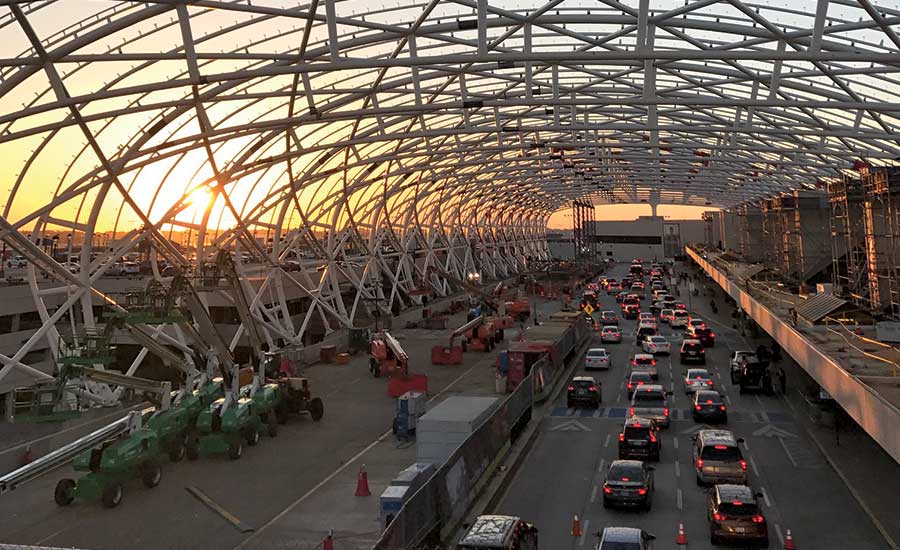 The airport canopies will “become the next architectural icon for the City of Atlanta,” the airport said in an announcement.
The airport canopies will “become the next architectural icon for the City of Atlanta,” the airport said in an announcement.
Construction of the first canopy at the Terminal North curbside is disrupting traffic from late evening into the early morning hours, but city and airport officials say it will all be worth it.
According to Vanderbilt University professor and history of art department chair Kevin D. Murphy, “having a vary unattractive airport, as Atlanta now does, can only create negative feelings about the city, which could have an economic impact as people choose to travel elsewhere.” Read more in The Atlanta Journal-Constitution, “Canopies to light up Atlanta airport’s otherwise dull domestic terminal,” article by Kelly Yamanouchi.
*Photograph courtesy of New South-McCarthy-Synergy, A Joint Venture, Atlanta, GA
Posted by vrcvanderbilt on October 5, 2018 in HART, News, Vanderbilt University, VRC
Lillian Boyle: Reflections on the Artistic Rhythms of Southern France, Part I
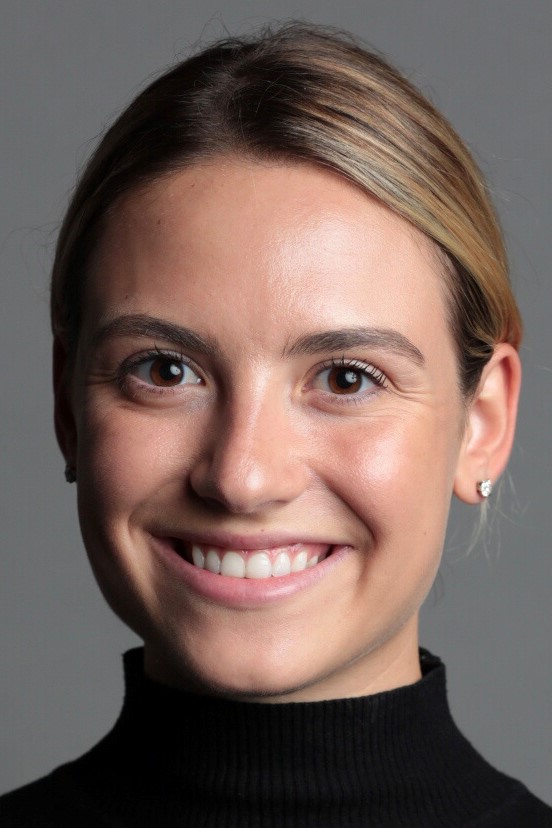 This blog entry, and another to follow, are among the final products of my on-site research this summer in the south of France, which was made possible by the generous support of a Downing Grant. As a History of Art graduate student at Vanderbilt, I spent three weeks conducting research between Marseille and Monaco, focusing primarily on Aix-en-Provence, Nîmes, Hyères, Antibes, Nice, Saint-Jean-Cap-Ferrat, Saint-Paul de Vence, and Roquebrune-Cap-Martin while exploring the region’s rich diversity of art and architecture. More than a travelogue, these posts offer an art historical approach to a variety of monuments based on close examination and analysis. My individual entries revolve around themes found throughout southern France such as multiculturalism and the impact of the environment on artistic creation, religion, and the lingering influence of the region’s classical past. This post addresses the first two themes.
This blog entry, and another to follow, are among the final products of my on-site research this summer in the south of France, which was made possible by the generous support of a Downing Grant. As a History of Art graduate student at Vanderbilt, I spent three weeks conducting research between Marseille and Monaco, focusing primarily on Aix-en-Provence, Nîmes, Hyères, Antibes, Nice, Saint-Jean-Cap-Ferrat, Saint-Paul de Vence, and Roquebrune-Cap-Martin while exploring the region’s rich diversity of art and architecture. More than a travelogue, these posts offer an art historical approach to a variety of monuments based on close examination and analysis. My individual entries revolve around themes found throughout southern France such as multiculturalism and the impact of the environment on artistic creation, religion, and the lingering influence of the region’s classical past. This post addresses the first two themes.
Multiculturalism in the South of France
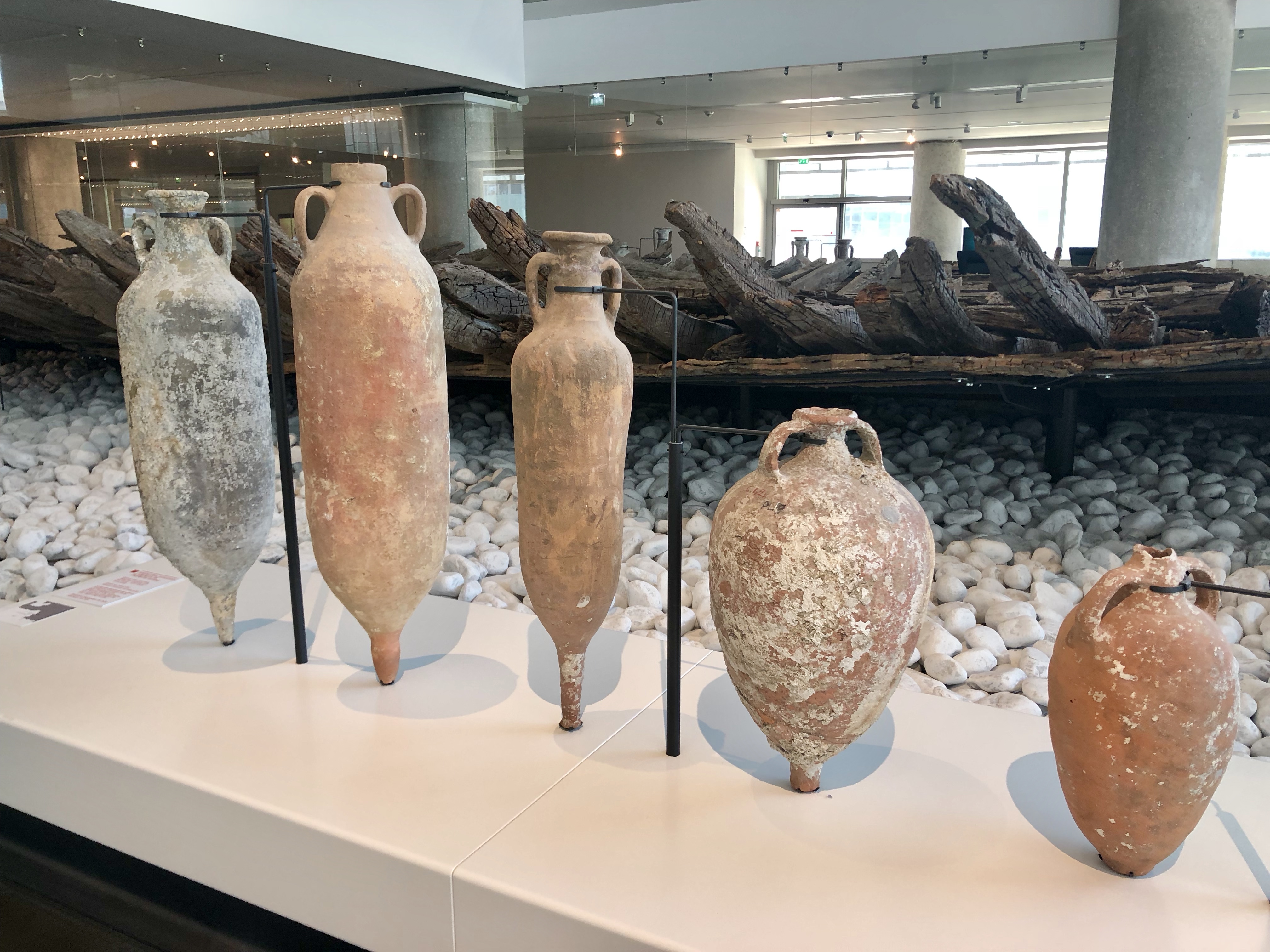 The blending of diverse cultures quickly emerged as a powerful theme in my research in Provence and the Côte d’Azur, beginning with my visit to the Musée d’Histoire de Marseille. Marseille (ancient Massalia) was founded ca. 600 BCE as a colony of Greek Phocaea, Asia Minor (modern Foça, Turkey). Ancient sources boil this down to a story that the city arose from the marriage of a Gallic princess (Gyptis) to a Phocaean sailor (Protis). The legend of Gyptis and Protis allegorizes the foundation of the city and epitomizes the cultural exchange between the Greeks of Ionia and the Gauls of Provence. The founding myth lays the groundwork for the multiculturalism that defines the past, present, and future of Marseille. As a port city and thus a trade center from the 6th century BCE to the present day, Marseille has long been the major regional locus for exchange of
The blending of diverse cultures quickly emerged as a powerful theme in my research in Provence and the Côte d’Azur, beginning with my visit to the Musée d’Histoire de Marseille. Marseille (ancient Massalia) was founded ca. 600 BCE as a colony of Greek Phocaea, Asia Minor (modern Foça, Turkey). Ancient sources boil this down to a story that the city arose from the marriage of a Gallic princess (Gyptis) to a Phocaean sailor (Protis). The legend of Gyptis and Protis allegorizes the foundation of the city and epitomizes the cultural exchange between the Greeks of Ionia and the Gauls of Provence. The founding myth lays the groundwork for the multiculturalism that defines the past, present, and future of Marseille. As a port city and thus a trade center from the 6th century BCE to the present day, Marseille has long been the major regional locus for exchange of 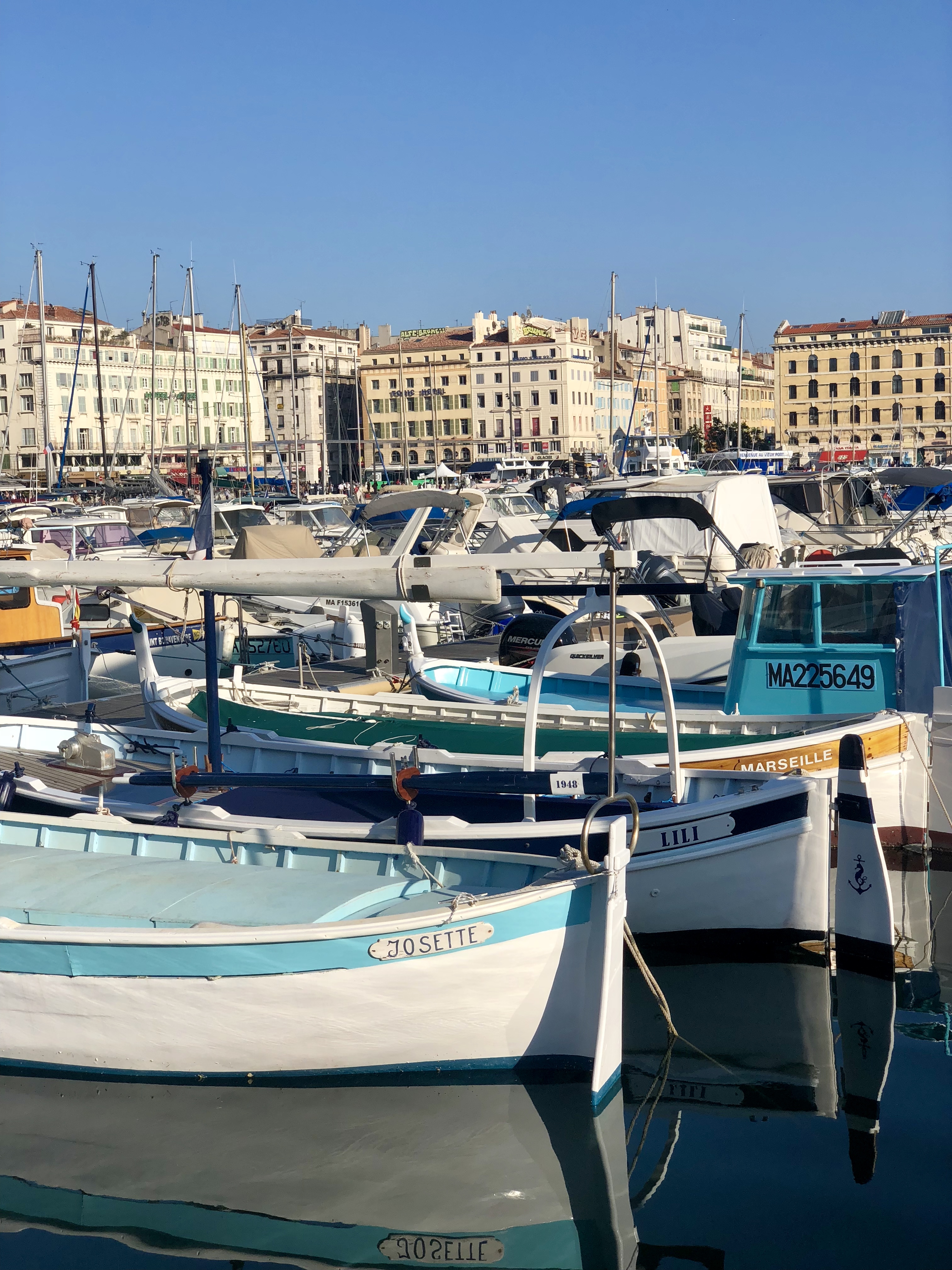 Mediterranean products, philosophies and cultures—from the Greek, then Roman, to the French, and between France and the modern world. The Musée d’Histoire de Marseille emphasizes this theme in its curatorial perspective, highlighting objects that serve as testaments to the city’s origins of multiculturalism. For example, the collection of amphorae from the 6th and 5th centuries BCE reflect the amazing breadth of cultures that traded with ancient Massalia—from North Africa, Italy, and the eastern Mediterranean to Spain and Portugal.
Mediterranean products, philosophies and cultures—from the Greek, then Roman, to the French, and between France and the modern world. The Musée d’Histoire de Marseille emphasizes this theme in its curatorial perspective, highlighting objects that serve as testaments to the city’s origins of multiculturalism. For example, the collection of amphorae from the 6th and 5th centuries BCE reflect the amazing breadth of cultures that traded with ancient Massalia—from North Africa, Italy, and the eastern Mediterranean to Spain and Portugal.
I turn to one of the major modern monuments in the city: The Cathédrale Sainte-Marie-Majeure de Marseille (or Cathédrale de la Major) designed by Léon Vaudoyer alongside Henri Espérandieu, director of construction, and built between 1845 and 1893, reflects the city’s multiculturalism by embracing many cultures and artistic eras 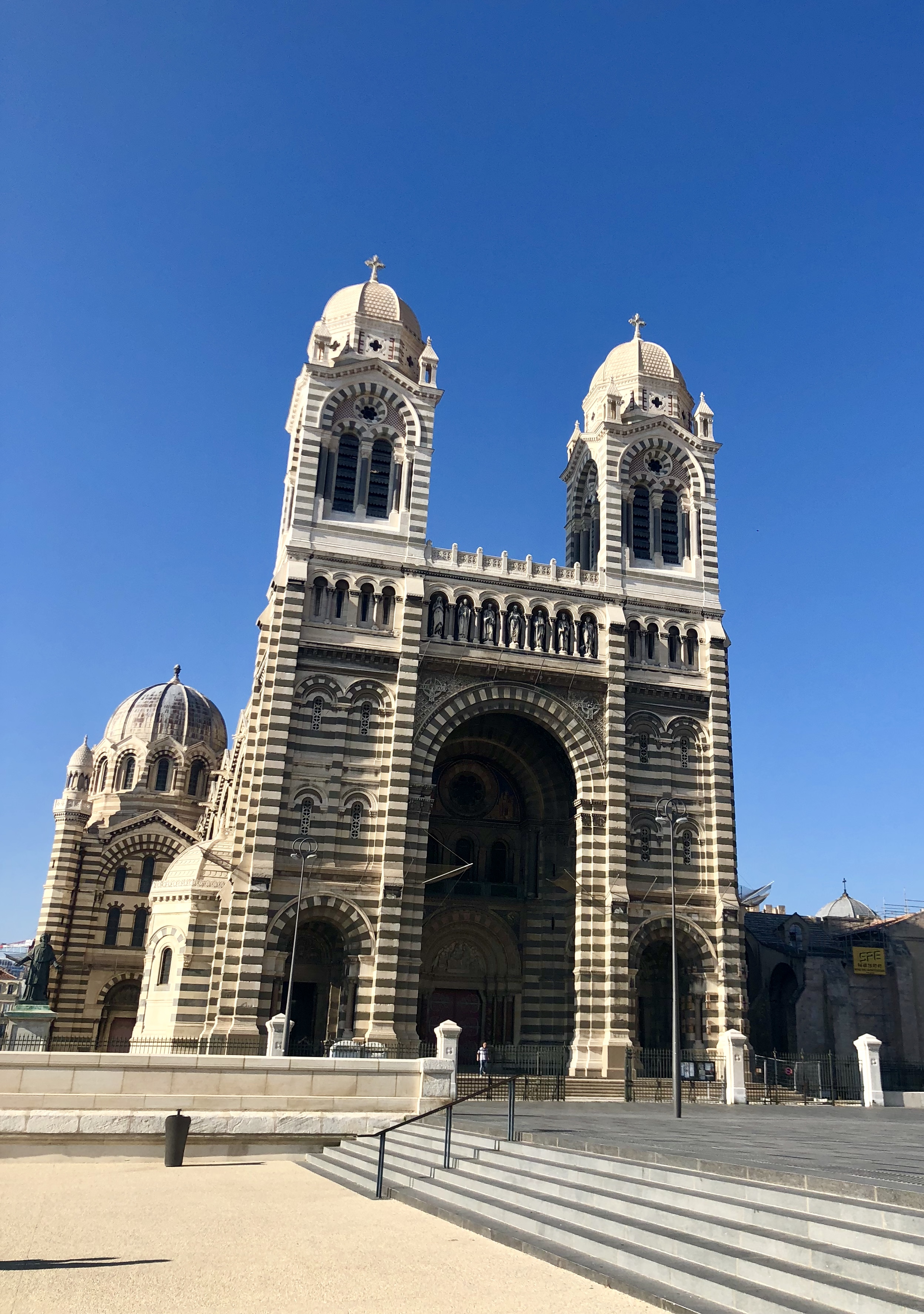 in its unique architectural style. The cathedral has a medieval pilgrimage plan, classical domes, Middle Eastern minarets inspired by Islamic art and Moorish stone polychromy. In addition to reflecting the diversity of the city, the cathedral sits on a platform above the harbor. This position reflects the significance of Marseille as a port city, while connecting the metaphor found in the architecture to the port bringing together many cultures.
in its unique architectural style. The cathedral has a medieval pilgrimage plan, classical domes, Middle Eastern minarets inspired by Islamic art and Moorish stone polychromy. In addition to reflecting the diversity of the city, the cathedral sits on a platform above the harbor. This position reflects the significance of Marseille as a port city, while connecting the metaphor found in the architecture to the port bringing together many cultures.
The mayor of Marseille, Jean-Claude Gaudin, reflects upon the significance of the city’s history as a port and the peaceful intermingling of various cultures there: “It’s a port and so we have always been used to having foreigners come here,” he says in an interview with National Geographic. Marseille’s current culture of respect and inclusivity reflects and affirms the city’s multicultural mythology and history.
One of the most compelling instances of cultural exchange is in Saint-Paul de 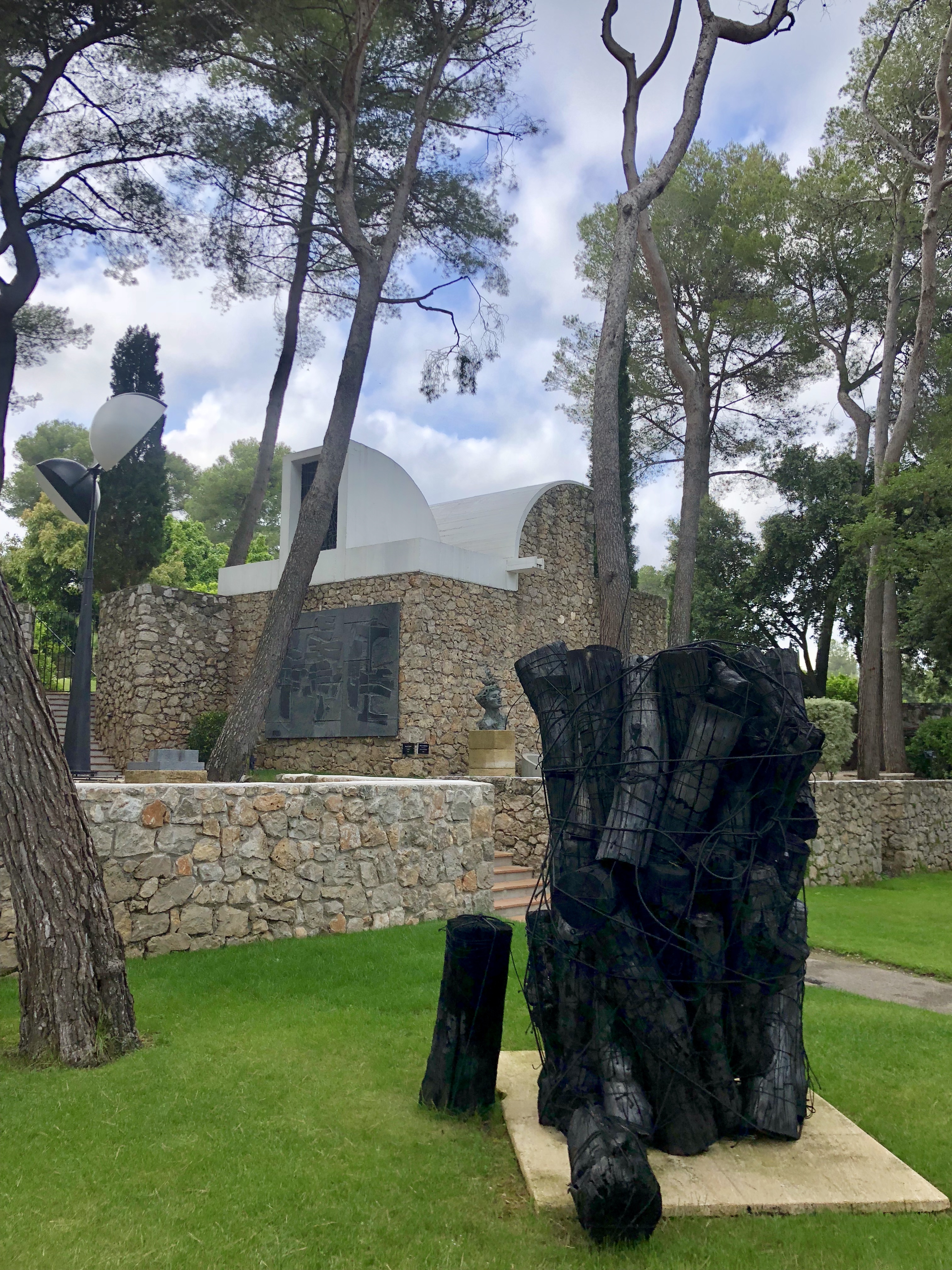 Vence at the Fondation Maeght. The exhibition there in the summer of 2018, Lee Bae: Plus de Lumière, showcases Bae’s work with charcoal, including canvases of abstract charcoal script and monumental sculptures of stacked charcoal, a traditional material from his native country of South Korea. His decision to bring his monumental works to the Fondation Maeght was largely inspired by his interest in the encounters between different cultures. Describing Issu de feu (2000), a sculpture composed of charcoal trunks tied with elastic threads, he shares the process and his philosophical approach: “I had the bundles sent from Cheongo, where I was born, near Daegu, in South Korea. I had them made in Korea; I brought them here as an encounter between the pines of Saint Paul and Korean pines. I like this idea of displacement, of travel, which corresponds to my way of thinking and what has been my way of life for going on thirty years, what with my regular journeys back and forth between France and my country of origin.”
Vence at the Fondation Maeght. The exhibition there in the summer of 2018, Lee Bae: Plus de Lumière, showcases Bae’s work with charcoal, including canvases of abstract charcoal script and monumental sculptures of stacked charcoal, a traditional material from his native country of South Korea. His decision to bring his monumental works to the Fondation Maeght was largely inspired by his interest in the encounters between different cultures. Describing Issu de feu (2000), a sculpture composed of charcoal trunks tied with elastic threads, he shares the process and his philosophical approach: “I had the bundles sent from Cheongo, where I was born, near Daegu, in South Korea. I had them made in Korea; I brought them here as an encounter between the pines of Saint Paul and Korean pines. I like this idea of displacement, of travel, which corresponds to my way of thinking and what has been my way of life for going on thirty years, what with my regular journeys back and forth between France and my country of origin.”
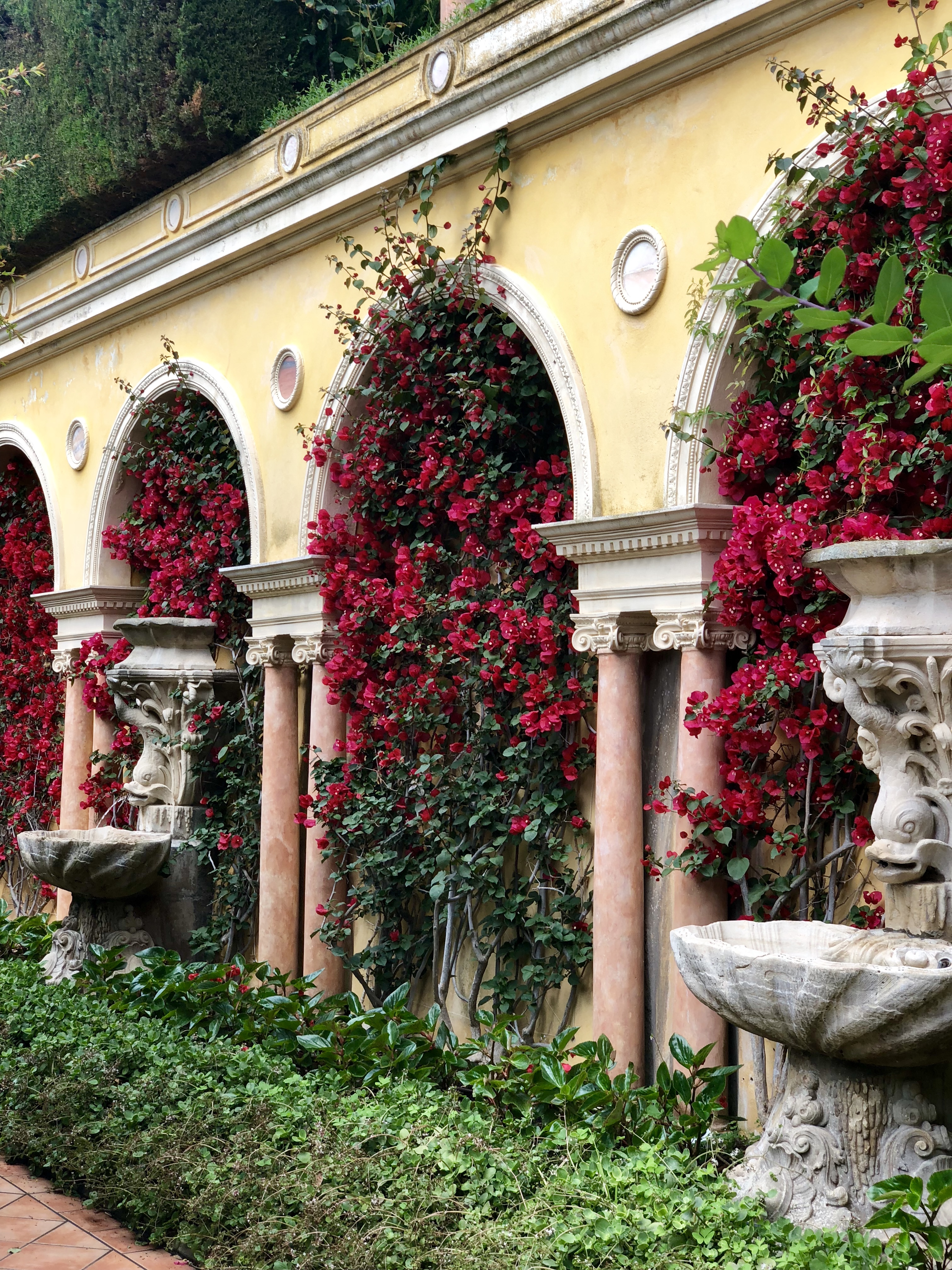 The idea of traveling between cultures also can be observed in Saint-Jean-Cap-Ferrat at Villa Ephrussi de Rothschild, the seaside mansion of Baroness Béatrice Ephrussi de Rothschild. The magnificent garden, designed by Achille Duchêne between 1905 and 1912, is divided into nine parts, many of which reflect different cultures ranging from Florentine to Spanish to Japanese to Provençal to French. This design enables one to move from one culture to the next, acting as a microcosm of an extensive cultural journey throughout the world and reflecting the experience of traveling throughout the culturally diverse Provence-Côte d’Azur region.
The idea of traveling between cultures also can be observed in Saint-Jean-Cap-Ferrat at Villa Ephrussi de Rothschild, the seaside mansion of Baroness Béatrice Ephrussi de Rothschild. The magnificent garden, designed by Achille Duchêne between 1905 and 1912, is divided into nine parts, many of which reflect different cultures ranging from Florentine to Spanish to Japanese to Provençal to French. This design enables one to move from one culture to the next, acting as a microcosm of an extensive cultural journey throughout the world and reflecting the experience of traveling throughout the culturally diverse Provence-Côte d’Azur region.
The Impact of the Environment on Artistic Creation in the South of France
The natural splendor of the region exerts a strong influence on art and architecture. By way of illustration, Montagne Sainte-Victoire in Aix-en-Provence inspired a series of paintings by Paul Cézanne, who was born in Aix and resided there for the majority of his life until his death in 1906. And of course, many will know of Vincent Van Gogh’s love of the region, specifically the town of Arles, although I did not have the opportunity to visit Fondation Vincent Van Gogh Arles. Finally, at Nice, the sea inspired Henri Matisse to stay and create the majority of his works there. In addition to inspiring paintings, the landscape of the South of France also plays a major role in shaping architecture.
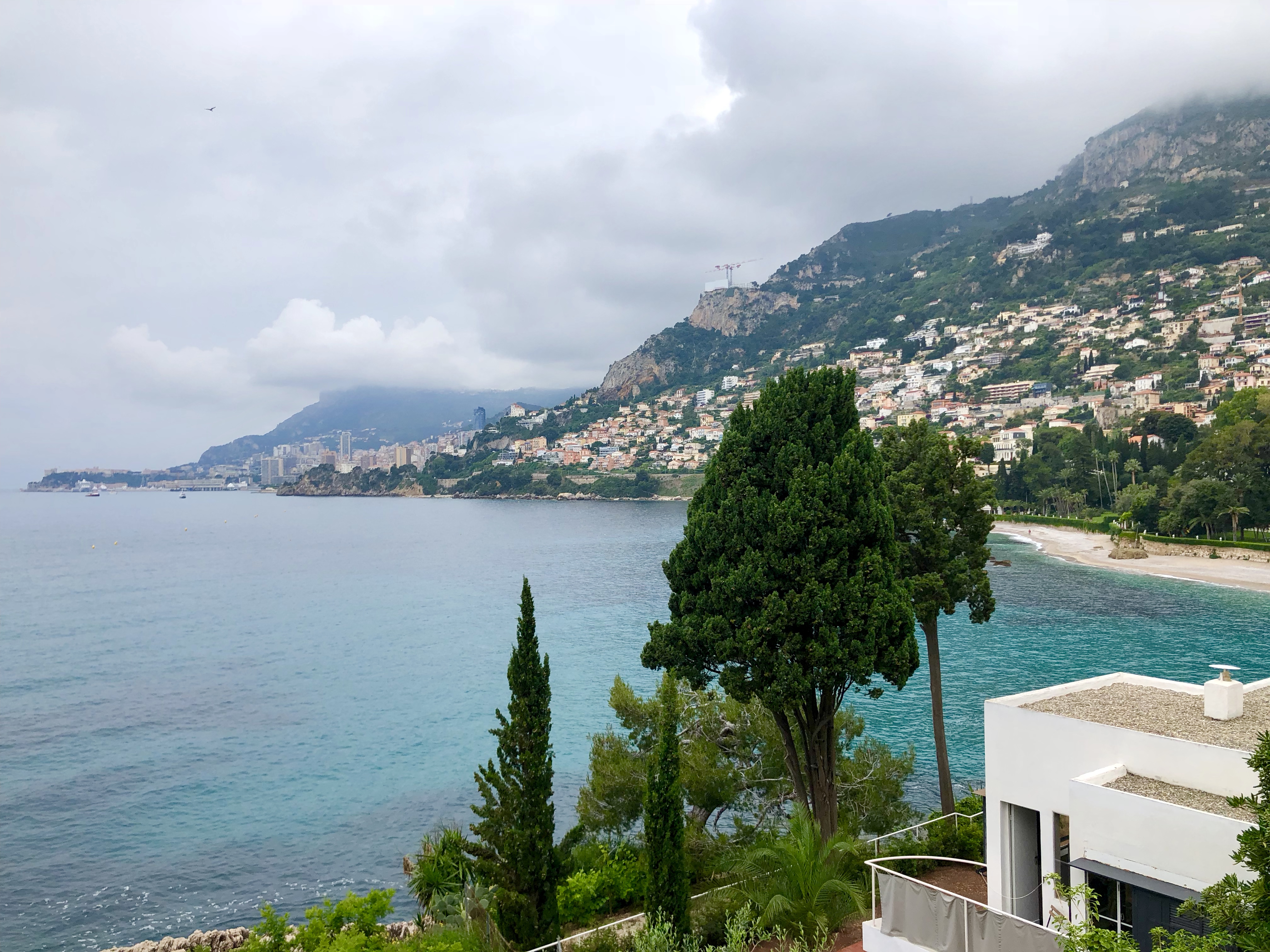 Architect Eileen Gray’s E1027 (1926-1929) in Roquebrune-Cap-Martin serves as a powerful example of the environment’s impact on architecture. The villa is perched on a rocky cliffside overlooking the Mediterranean Sea. The minimalist, whitewashed exterior of the home and the flat roof ensure that the architecture complements the natural surroundings. A long terrace stretches across the house, emphasizing the vista. The house can only be entered in groups organized at the Cap Moderne visitor center, and on my visit, the official guide memorably stated that the true luxury of the home was the view, in response to a comment about the villa’s minimalism. Gray’s design positions the viewer to experience the vista throughout the villa, as one even has a great view from the bathroom!
Architect Eileen Gray’s E1027 (1926-1929) in Roquebrune-Cap-Martin serves as a powerful example of the environment’s impact on architecture. The villa is perched on a rocky cliffside overlooking the Mediterranean Sea. The minimalist, whitewashed exterior of the home and the flat roof ensure that the architecture complements the natural surroundings. A long terrace stretches across the house, emphasizing the vista. The house can only be entered in groups organized at the Cap Moderne visitor center, and on my visit, the official guide memorably stated that the true luxury of the home was the view, in response to a comment about the villa’s minimalism. Gray’s design positions the viewer to experience the vista throughout the villa, as one even has a great view from the bathroom!
Nature further influences the architecture, as the villa is oriented to maximize sunlight: “the bedrooms face east to take advantage of the morning sun, and the 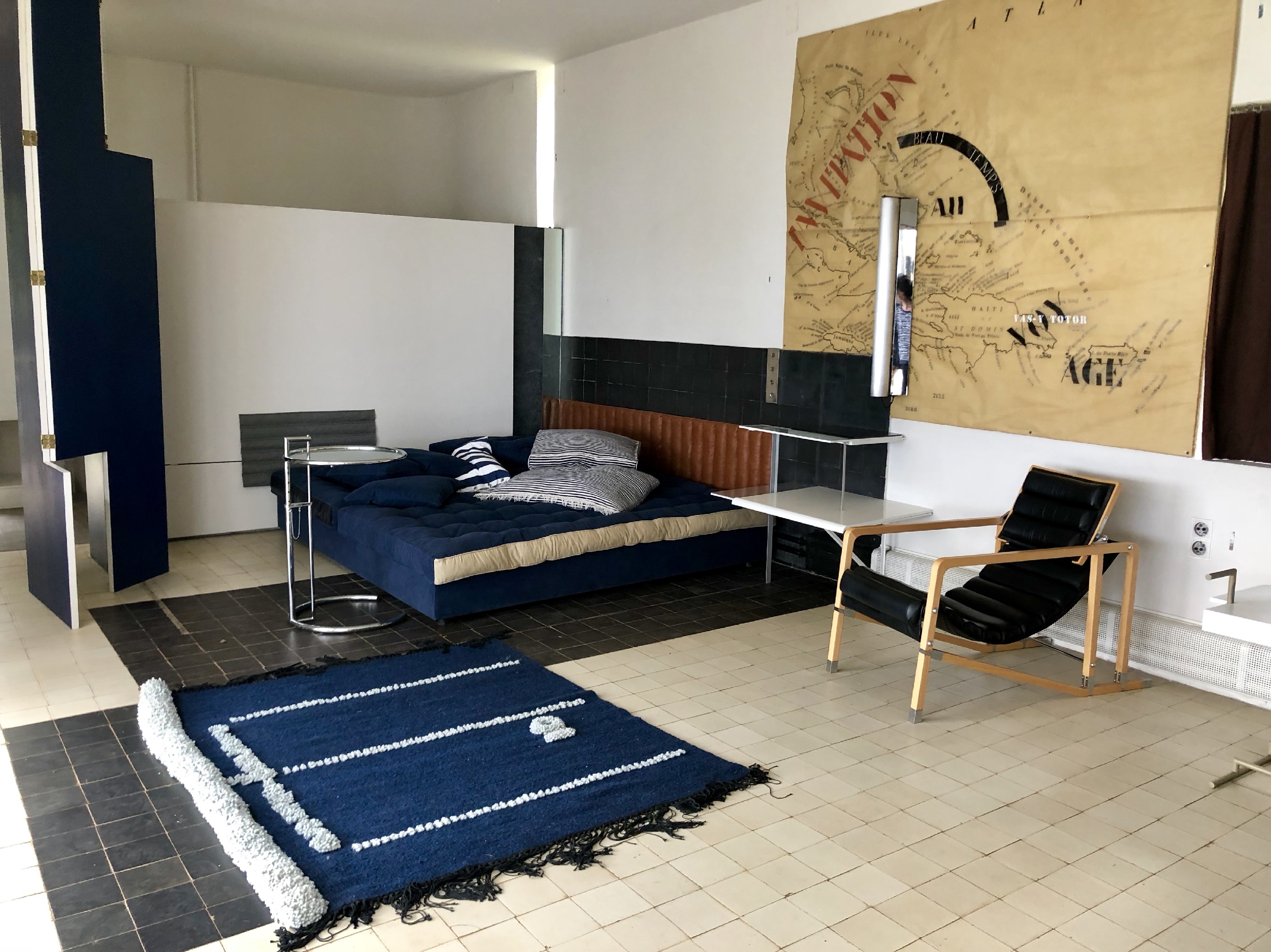 main living area faces full south towards the sea for natural light throughout the day” (Cap Moderne Museum). Nature seeps deeper into the villa, as the four dominant colors are borrowed from the surroundings: green, red, blue and white. The villa also features a blossoming garden, which is emphasized through the leisurely approach towards the entrance to the villa.
main living area faces full south towards the sea for natural light throughout the day” (Cap Moderne Museum). Nature seeps deeper into the villa, as the four dominant colors are borrowed from the surroundings: green, red, blue and white. The villa also features a blossoming garden, which is emphasized through the leisurely approach towards the entrance to the villa.
The water inspires another aspect, the villa’s nautical theme. E1027 mimics a boat floating above the water, as pointed out in the nearby museum: The terrace  emulates a ship’s deck, complete with “canvas covered railings and lifebuoys” and its staircase acts as an anchor. In the main room, a map of the Caribbean with the words “Invitation au Voyage” represents both the nautical theme and the book and poem by Charles Baudelaire of the same title from 1857. The furniture is mostly blue and white, featuring nautical stripes. According to the Cap Moderne Museum, the name of the home even stems from maritime registration numbers, although some believe the number is a clever combination of Gray’s name and the name of her lover and fellow architect, Jean Badovici, for whom she built the villa. Notwithstanding, E1027 clearly pays homage to the sea through its emphasis on vistas, incorporation of elements from the surrounding landscape, and the maritime theme.
emulates a ship’s deck, complete with “canvas covered railings and lifebuoys” and its staircase acts as an anchor. In the main room, a map of the Caribbean with the words “Invitation au Voyage” represents both the nautical theme and the book and poem by Charles Baudelaire of the same title from 1857. The furniture is mostly blue and white, featuring nautical stripes. According to the Cap Moderne Museum, the name of the home even stems from maritime registration numbers, although some believe the number is a clever combination of Gray’s name and the name of her lover and fellow architect, Jean Badovici, for whom she built the villa. Notwithstanding, E1027 clearly pays homage to the sea through its emphasis on vistas, incorporation of elements from the surrounding landscape, and the maritime theme.
Across the entire region, the natural beauty of the land and sea has sparked an interest in preserving the environment. The collection at Château La Coste reflects an environmentalist philosophy througho ut the vineyard and outdoor art center. The Art and Architecture Walk highlights the property’s large-scale installations by such esteemed artists and architects as Louise Bourgeois, Alexander Calder, Richard Serra, Frank Gehry, Jean Nouvel, and Tadao Ando. Five of Ando’s works are featured on the Art and Architecture Walk, including Pavilion, Four Cubes to Contemplate our Environment (2008-2011). The glass installation consists of four cubes that work together to serve as a call to action; the artist intends for this work to inspire environmentalism: “I would like people to think of what they could do to improve things when they look into the box” (Château La Coste Art and Architecture Walk). The first three cubes are marked with repeating labels, such as “CO2,” “WATER,” and “RUBBISH” and feature items inside reflecting their respective labels.
ut the vineyard and outdoor art center. The Art and Architecture Walk highlights the property’s large-scale installations by such esteemed artists and architects as Louise Bourgeois, Alexander Calder, Richard Serra, Frank Gehry, Jean Nouvel, and Tadao Ando. Five of Ando’s works are featured on the Art and Architecture Walk, including Pavilion, Four Cubes to Contemplate our Environment (2008-2011). The glass installation consists of four cubes that work together to serve as a call to action; the artist intends for this work to inspire environmentalism: “I would like people to think of what they could do to improve things when they look into the box” (Château La Coste Art and Architecture Walk). The first three cubes are marked with repeating labels, such as “CO2,” “WATER,” and “RUBBISH” and feature items inside reflecting their respective labels.
 The fourth cube is especially poignant, as the word “FUTURE?” repeats against an empty cube. I was reminded of this question, “FUTURE?” when I saw Monaco’s oil rigs and the pollution that abound in Marseille’s Vieux Port, and also when I saw the Mediterranean Sea from E1027 and the cliffs of Montagne Sainte-Victoire from the Bibemus Quarry nearby. Such juxtapositions serve as reminders that these pockets of natural splendor need our protection, now more than ever.
The fourth cube is especially poignant, as the word “FUTURE?” repeats against an empty cube. I was reminded of this question, “FUTURE?” when I saw Monaco’s oil rigs and the pollution that abound in Marseille’s Vieux Port, and also when I saw the Mediterranean Sea from E1027 and the cliffs of Montagne Sainte-Victoire from the Bibemus Quarry nearby. Such juxtapositions serve as reminders that these pockets of natural splendor need our protection, now more than ever.
Posted by vrcvanderbilt on October 4, 2018 in HART, News, Student/Alumni, VRC
HART Students Liz Horner and Michelle Zhu Awarded Downing Grants
The Department of History of Art has awarded Downing undergraduate research grants to Liz Horner and Michelle Zhu, both of whom are working with Christopher Johns, the Norman L. and Roselea J. Goldberg Professor of History of Art.
Horner will travel to New York in early November for research in the Provenance Research Project of MoMA and the works now in their permanent collection deemed “degenerate” by the Nazis. She will also visit the Neue Galerie, which owns Gustav Klimt’s Adele Bloch-Bauer I (1907), the portrait in one of the most notorious cases of restitution, Republic of Austria v. Altmann (2004). The trip will provide material for her Honors thesis, “Art in War: The Legal Implications of Looting, Repatriation, and Restitution.”
Zhu will use the grant to travel to several collections in Germany that are essential for her Honors thesis on the landscapes of German Romantic painters Philipp Otto Runge and Caspar David Friedrich and their religious, literary, and philosophical milieux. Based in Vienna for the spring semester, Zhu plans to travel to see works by these artists in the extraordinary museums in Hamburg, Dresden and Bertlin.
The department awards these Downing grants for travel to exhibitions and research centers to supplement academic instruction for HART majors who are in the Honors Program, in advanced seminars, or in upper-level “W” (writing) courses. These grants provide assistance for up to $1,500 in travel costs and are awarded in the fall and spring semesters of each academic year.
Posted by vrcvanderbilt on October 3, 2018 in HART, News, Student/Alumni, Vanderbilt University, VRC
Mireille Lee to Address Modern Collections of Ancient Greek Mirrors on October 6
With the rise of new technologies, the definition of objects is changing along with our understanding of collecting. Collectibles are no longer limited to their material shape but also appear on screen, retrieved from source codes and algorithms. The simultaneity of actual and virtual objects is transforming our cultural memory. Concepts of our past and projections of our future increasingly rely on “collections” of data to preserve, protect, and produce memory. Traditionally considered a form of human self-understanding, the social practice of collecting today serves to memorialize culture in ways that exceed the capacities of museums and archives. Indeed, the technological achievements of the past two decades necessitate a redefinition of the concept of collecting as a whole.
Vanderbilt’s Department of History of Art, Fine Arts Gallery, Department of Art, and Department of German, Russian & East European Studies are among the many sponsors of a four-day international conference addressing “Memorizing the Future: Collecting in the 21st Century” held October 4-7 at various venues. Mireille Lee, assistant professor of history of art, will serve on a panel on Saturday, October 6, from 8:30 to 10:00 a.m. in the Central Library Community Room. Her paper is entitled “Modern Collections of Ancient Greek Mirrors: Appropriating the Past, Reflecting the Present, Imag(in)ing the Future.”
Lee is a specialist in the art and archaeology of ancient Greece, with a special interest in constructions of gender in ancient Greek society. Her first book, Body, Dress, and Identity in Ancient Greece was published by Cambridge University in 2015. She is now writing a monograph on ancient Greek mirrors for Oxford University Press. She has won fellowships from the American Council of Learned Societies, the Center for Advanced Studies in the Visual Arts, National Gallery of Art, and the Center for Hellenic Studies, Harvard University, among others. She has a special interest in cultural heritage issues, and the potential of technology to protect and preserve the remains of the past for the future.
The conference’s goal is to lay the foundation for a new theory of collecting in the light of both the most recent and anticipated technological innovations. It aims to facilitate dialogues between scholars from different academic fields, artists, archivists, curators, and IT experts; to reassess our traditional understanding of cultural memory in light of technological advances; to examine how the private and public spheres of collection are merging or diverging, and identify how both collecting institutions and individual collectors are reaching out to their virtual and actual visitors and followers; and to determine the common interests that academia, institutions, and businesses as well as private collectors share in a market of collecting.
Posted by vrcvanderbilt on October 3, 2018 in Conferences, Digital Humanities, Events, Fine Arts Gallery, HART, Lectures, News, Technology, Vanderbilt University, VRC
Virtual Archaeologist Bernard Frischer to Deliver Goldberg Lecture on October 11
 Bernard Frischer, a leading virtual archaeologist and director of the Virtual Heritage Program and professor of informatics at Indiana University, will deliver the Norman L. and Roselea J. Goldberg Lecture on Thursday, October 11, at 4:10 pm in 203 Cohen Memorial Hall on the Peabody campus. Frischer, founding director of the Virtual World Heritage Laboratory, will bring ancient Rome back to life in his lecture, “Adventures in Digital Heritage,” with a reception to follow in the atrium.
Bernard Frischer, a leading virtual archaeologist and director of the Virtual Heritage Program and professor of informatics at Indiana University, will deliver the Norman L. and Roselea J. Goldberg Lecture on Thursday, October 11, at 4:10 pm in 203 Cohen Memorial Hall on the Peabody campus. Frischer, founding director of the Virtual World Heritage Laboratory, will bring ancient Rome back to life in his lecture, “Adventures in Digital Heritage,” with a reception to follow in the atrium.
The Rome Reborn project, directed by Frischer, is an international initiative, launched in 1996, to create an interactive 3D reconstruction of the ancient city of Rome within the Aurelian Walls as it appeared in 320 CE—the peak of its ancient development, shortly before the Imperial capital was moved to Constantinople. After 22 years of hard work by an interdisciplinary team, the model was completed in August and made available to scholars and the general public through the VR publisher Flyover Zone Productions.
Rome Reborn offers bird’s-eye and ground views of the Eternal City with red-roofed buildings and massive marble statues and temples. “The Rome Reborn project is the continuation of five centuries of research by scholars, architects and artists since the Renaissance who have attempted to restore the ruins of the ancient city with words, maps and images,” said Frischer, who is the founding editor of Digital Applications in Archaeology and Cultural Heritage, an on-line, peer-reviewed journal in which scholars can publish 3D digital models of the world’s cultural heritage sites, monuments, and paleoanthropological remains.
His lecture will explore Rome Reborn as a tool of discovery in Roman topography and urban history. Until now, Roman topographers have approached the Imperial  city by concentrating on a specific monument or the projects of an individual emperor or dynasty. Now, thanks to the availability of this interactive city model, we can look at the city in more holistic, synchronic, and dynamic ways. In fact, Rome Reborn allows us to make observations and to run experiments in ways previously impossible without time-travel. In his lecture Frischer will include case studies on the alignments of monuments, dynamic viewshed analysis, and evidence of urban planning and land use across the entire cityscape.
city by concentrating on a specific monument or the projects of an individual emperor or dynasty. Now, thanks to the availability of this interactive city model, we can look at the city in more holistic, synchronic, and dynamic ways. In fact, Rome Reborn allows us to make observations and to run experiments in ways previously impossible without time-travel. In his lecture Frischer will include case studies on the alignments of monuments, dynamic viewshed analysis, and evidence of urban planning and land use across the entire cityscape.
Free and open to the public, the Goldberg Lecture is sponsored by the Department of History of Art, with support from the Vanderbilt University Center for Digital Humanities, the Archaeological Institute of America, and the Conservancy for the Parthenon and Centennial Park. Parking is available in all non-reserved spaces in Lot 95 near Cohen Hall on the Peabody campus.
§
Prior to his Goldberg lecture on October 11, Frischer will present “Rome Reborn VR: A Demonstration of Recently Published Applications,” a hands-on workshop (with lunch) held from 12:30 to 2 pm in the History of Art’s Visual Resources Center, 134 Cohen Memorial Hall. Participants will be able to use the Oculus Go headset to try out the project’s recently published applications, including “The Roman Forum” and “A Flight over the Ancient City.” Sponsors are the Department of History of Art, Digital Humanities Center, and Digital Cultural Heritage Research Cluster. Everyone is invited to come by the VRC and have lunch and explore ancient Rome with us!
Posted by vrcvanderbilt on October 2, 2018 in Events, HART, Lectures, News, Vanderbilt University, VRC

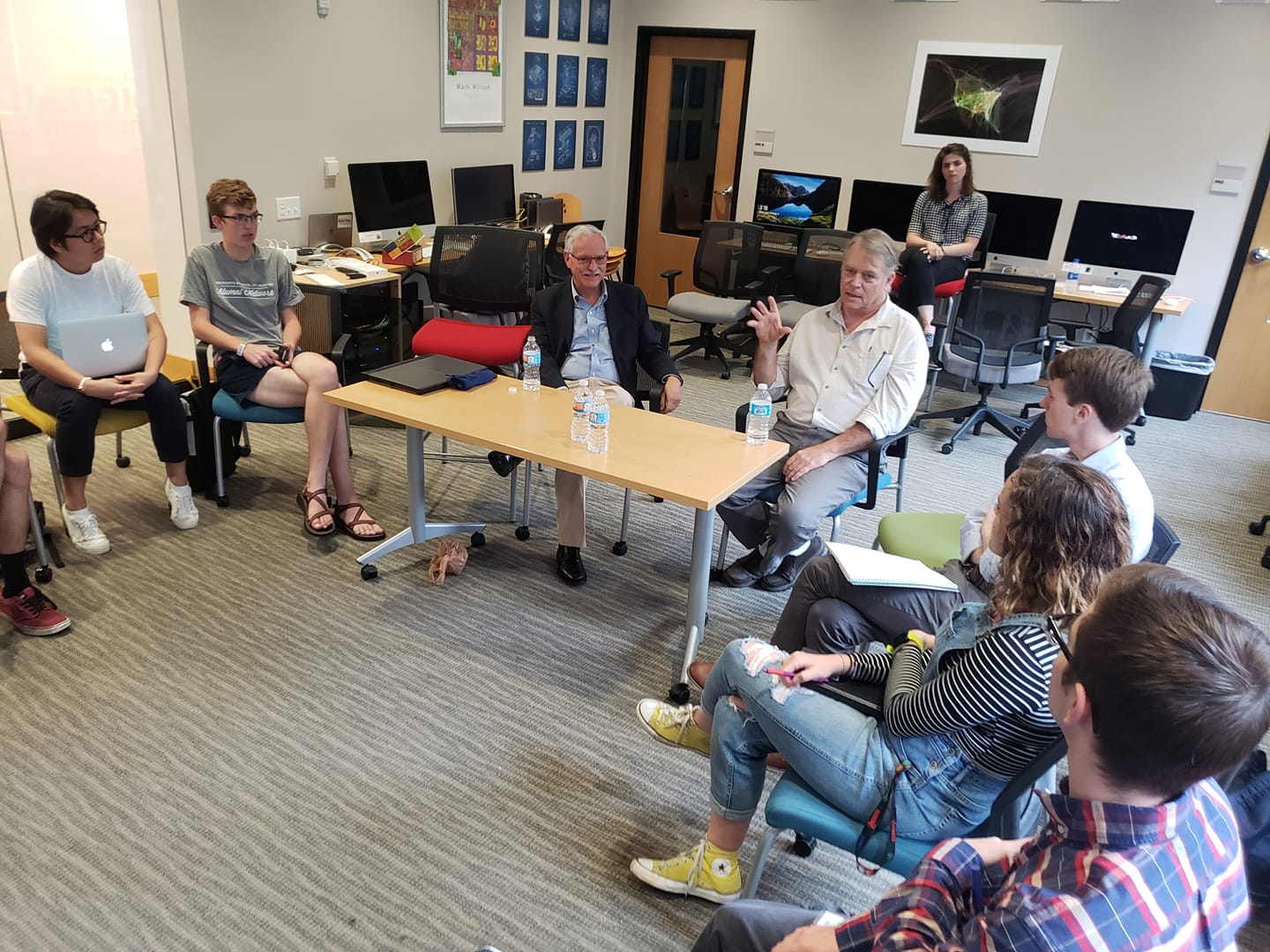
©2026 Vanderbilt University ·
Site Development: University Web Communications